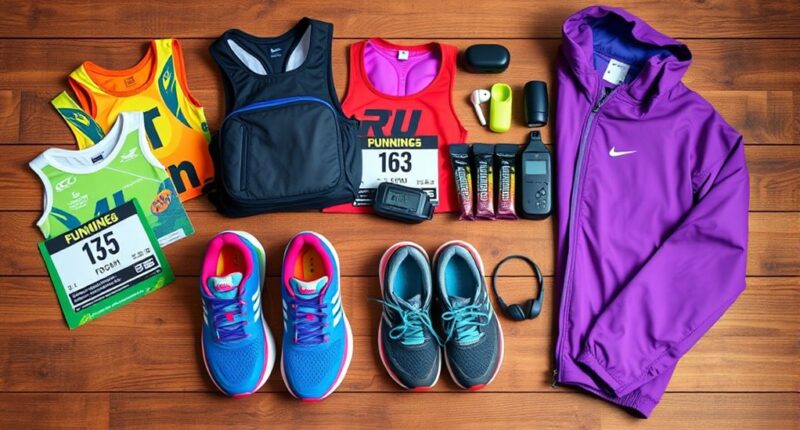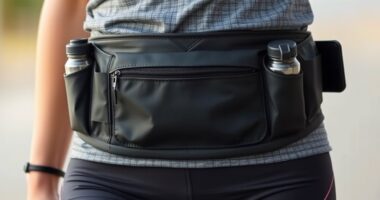For every race distance, you’ll need the right gear. For short 5K sprints, focus on lightweight shoes, moisture-wicking clothes, and a GPS watch for pace tracking. As distances grow, add hydration gear, energy gels, and spare clothing. Ultra distances demand sturdy trail shoes, trekking poles, and multi-day nutrition plans. Whether you’re running a quick race or an epic ultra, optimize your gear to perform at your best—discover more tips for every step ahead.
Key Takeaways
- Match gear to race distance: lighter setups for 5K, more hydration and nutrition for ultra-marathons.
- Prioritize proper footwear: cushioned shoes for shorter runs, trail or supportive shoes for longer, technical courses.
- Include safety and navigation tools: reflective gear, headlamp, map, and communication devices based on race terrain and time.
- Pack appropriate nutrition and hydration: gels, chews, water bottles, or hydration packs suited for the event length.
- Prepare weather-specific clothing and extra supplies: layers, rain gear, extra socks, and backup gear for unpredictable conditions.
Essential Gear for 5K Races
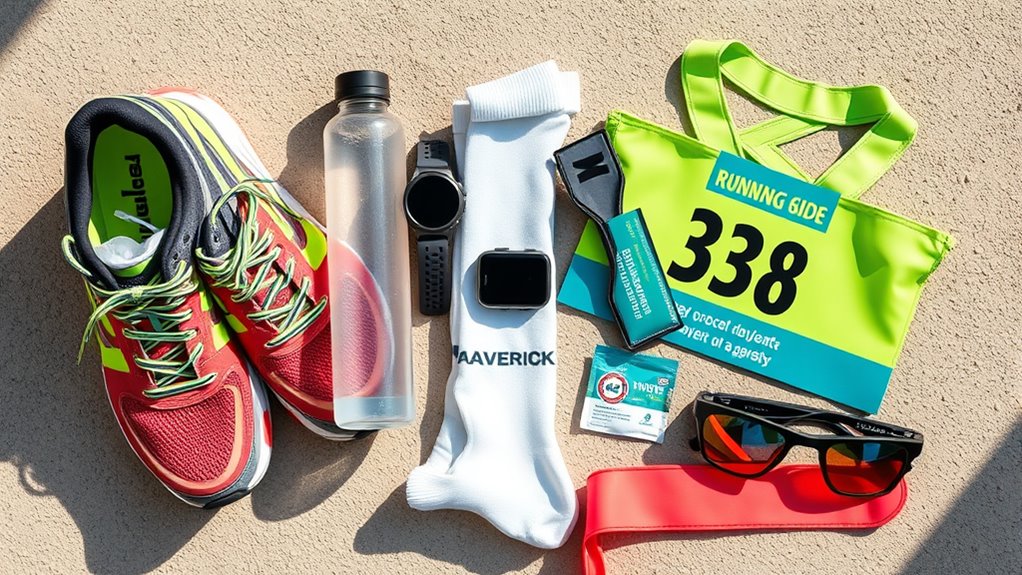
Preparing for a 5K race requires the right gear to guarantee you perform your best and stay comfortable. Your race day nutrition is vital—fueling properly ensures energy levels stay high from start to finish. Consider easy-to-digest snacks or hydration options to keep your body fueled. Equally important is your running shoe technology; choose shoes that provide lightweight support, cushioning, and a secure fit. Modern running shoes are designed to enhance speed and reduce fatigue, giving you an edge on race day. Proper gear helps you stay focused, minimizes discomfort, and boosts confidence. Additionally, selecting appropriate footwear designed for your gait and foot structure can prevent injuries and improve overall performance. The role of shoe technology in reducing impact and enhancing efficiency is crucial for long-term health and success. Ensuring your gear aligns with training principles can also help you optimize your preparation and recovery. Incorporating performance-focused equipment can further elevate your race experience. Remember, investing in the right shoes and planning your nutrition sets the foundation for a successful 5K, allowing you to enjoy the race and reach your goals.
Must-Have Items for 10K Events
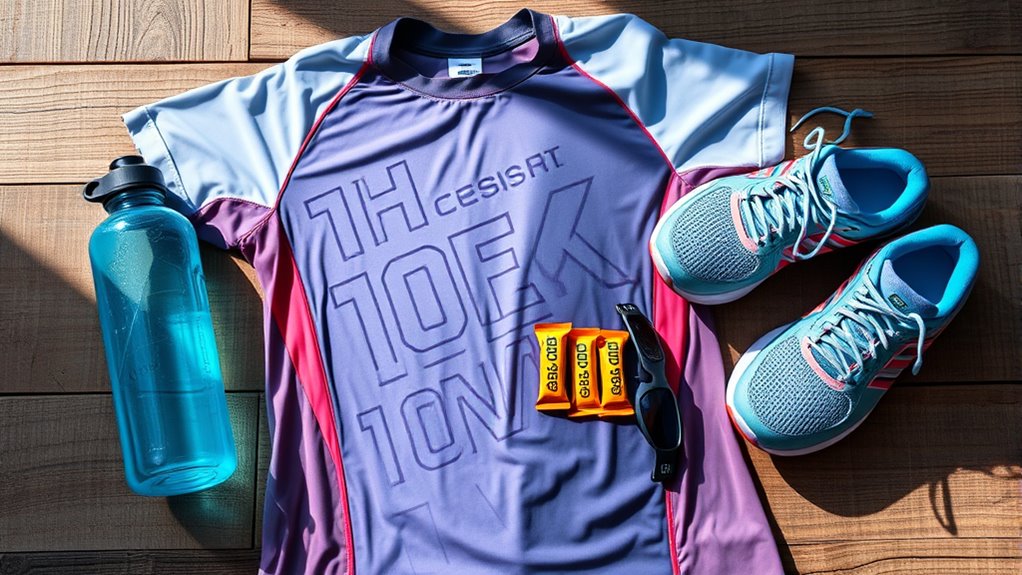
For a successful 10K event, having the right gear can make all the difference in your performance and comfort. Your running shoe selection is vital—you need shoes that fit well, provide support, and suit your running style. Don’t forget race day nutrition; lightweight gels or chews help maintain energy without weighing you down. Hydration is key, so carry a small water bottle or plan water stops. A sweat-wicking shirt and comfortable shorts keep you cool. Consider wearing sunglasses and a hat to protect against the sun. Use the table below to check off essentials:
| Item | Purpose |
|---|---|
| Running shoes | Support and comfort |
| Race nutrition | Maintain energy levels |
| Hydration gear | Prevent dehydration |
| Sun protection | Shield from sun exposure |
Gear List for Half-Marathon Success
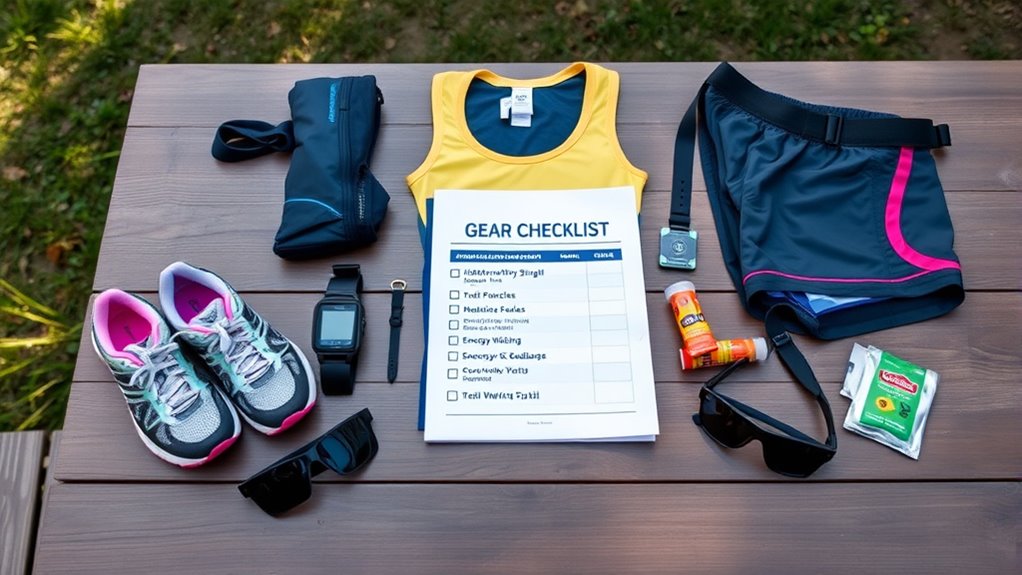
To guarantee a successful half-marathon, assembling the right gear is essential for comfort, performance, and endurance. Your running shoes should incorporate advanced running shoe technology to provide *ideal* support, cushioning, and flexibility during the race. Proper footwear helps prevent injuries and keeps you comfortable mile after mile. Alongside your shoes, race day accessories like a lightweight hat, sunglasses, and moisture-wicking clothing can help manage sun, sweat, and wind. Don’t forget a GPS watch or fitness tracker to monitor your pace and heart rate. Carrying energy gels or chews can boost your stamina when needed. Ensuring your gear is well-chosen and functional allows you to focus on your run, stay motivated, and cross the finish line strong. Incorporating sound effect libraries can also help you stay motivated with energizing playlists or audio cues to keep your pace consistent.
Equipment for Full Marathons
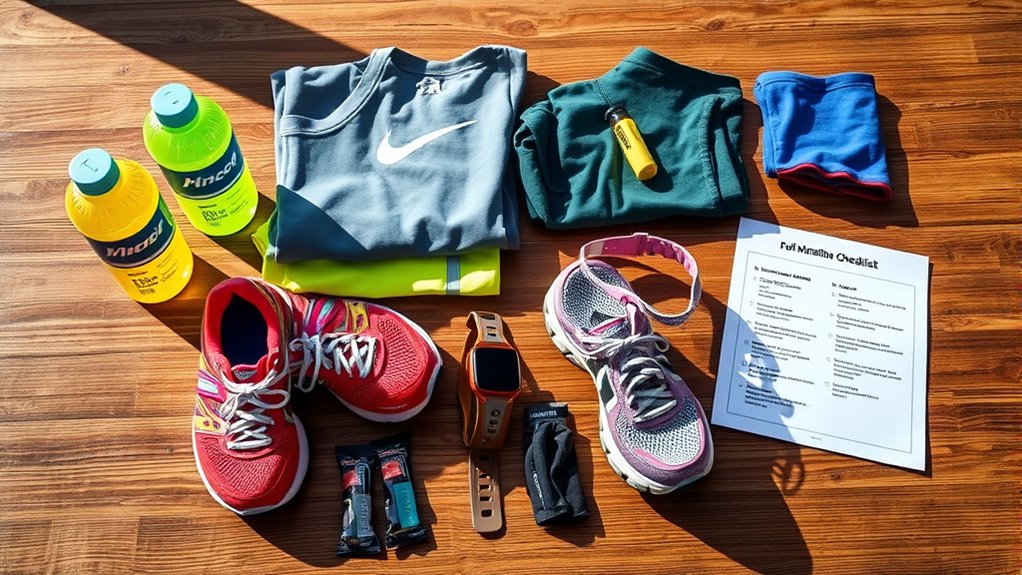
Running a full marathon demands specialized equipment that supports your endurance and helps prevent injuries. Proper gear keeps you comfortable and focused on your marathon pacing, especially during those critical miles. Essential items include well-cushioned shoes, moisture-wicking clothing, and a race belt for your race day nutrition.
| Item | Purpose | Tips |
|---|---|---|
| Lightweight shoes | Support, cushioning, injury prevention | Break them in before race day |
| Hydration pack | Stay fueled and hydrated | Practice with it during training |
| Energy gels | Quick carbs for marathon pacing | Carry enough for the distance |
This gear ensures you stay comfortable, fueled, and injury-free through every mile.
Ultra-Marathon Running Essentials

When tackling an ultra-marathon, you need to prioritize hydration and nutrition gear to keep your energy steady. Make sure your clothing and layering strategies suit changing conditions, and carry safety and navigation tools to stay on track. Being prepared with these essentials will help you finish strong and safe. Additionally, understanding best colognes for men can boost your confidence and presentation during your race or post-race activities. Proper comfort solutions for gear can also enhance your overall experience by reducing discomfort during long runs. Incorporating AI-powered virtual reality in e-learning can offer valuable training simulations to improve your race strategies and mental preparedness. Understanding trademark protection can help you safeguard your unique gear and branding during your training and events.
Hydration & Nutrition Gear
Proper hydration and nutrition are critical for maintaining your energy and stamina during an ultra-marathon, so packing the right gear can make all the difference. Your hydration pack ensures you stay fueled and hydrated on the move, while energy gels provide quick, easily digestible calories when you need a boost. Be sure to carry enough supplies to last the entire race, especially in remote sections. Consider packing:
- Multiple energy gels for quick energy
- A durable hydration pack with ample capacity
- Electrolyte tablets or powder for balance
- Small, lightweight snack options for variety
Having these essentials accessible helps you manage your energy levels effectively, preventing bonking and dehydration. Tailor your gear to your pace, preferences, and race course to stay optimized from start to finish. Additionally, understanding the horsepower of electric dirt bikes can inspire ideas for lightweight, high-performance gear that enhances your endurance.
Clothing & Layering Strategies
Effective clothing and layering strategies are essential for maintaining comfort and temperature regulation throughout an ultra-marathon. Start with moisture wicking fabrics close to your skin to keep sweat away and prevent chafing. Add lightweight, breathable layers that can be easily removed or added as your body temperature fluctuates. Consider thermal insulation layers for colder conditions, which trap heat without adding bulk. Use a windproof or waterproof outer layer if weather turns sour, but keep it lightweight to avoid overheating. Focus on versatile pieces that dry quickly and pack easily. Remember, your clothing choices should adapt to changing temperatures, terrain, and weather. Proper layering ensures you stay dry, comfortable, and ready to conquer long miles without distraction.
Have you packed the essential safety and navigation tools to keep you on course and prepared for emergencies? Ultra-marathon running demands reliable gear to guarantee your safety. Consider carrying a GPS tracking device to monitor your location and help rescuers find you if needed. Emergency signaling tools, like a whistle or mirror, can attract attention if you get lost or injured. A lightweight map and compass can serve as backup navigation if electronics fail. Additionally, pack a small first aid kit for minor injuries. These tools help you stay on track and respond quickly to unexpected situations, giving you peace of mind during your race. Proper safety gear is crucial for tackling the challenges of ultra-distance races safely and confidently.
Gear for Multi-Day Stage Races
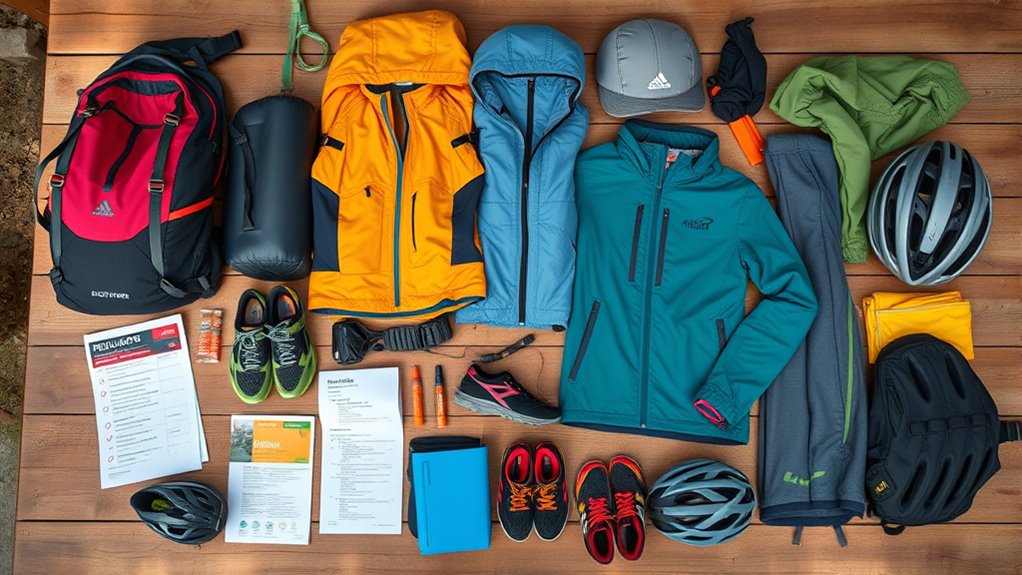
When preparing for multi-day stage races, you need gear that balances durability, versatility, and lightweight design. Your race nutrition plan is essential; pack enough energy gels, bars, and electrolyte drinks to sustain you across multiple days. Proper footwear selection is critical—choose shoes that offer support, breathability, and durability, since you’ll be covering diverse terrain day after day. Opt for lightweight trail shoes with good grip to prevent blisters and fatigue. Pack extra insoles and laces for quick replacements. Don’t forget essentials like a multi-day hydration system and quick-drying clothing. Having the right gear ensures you stay fueled, comfortable, and prepared for variable conditions, allowing you to focus on finishing strong without unnecessary distractions or discomfort.
Specialized Gear for Mountain and Trail Races
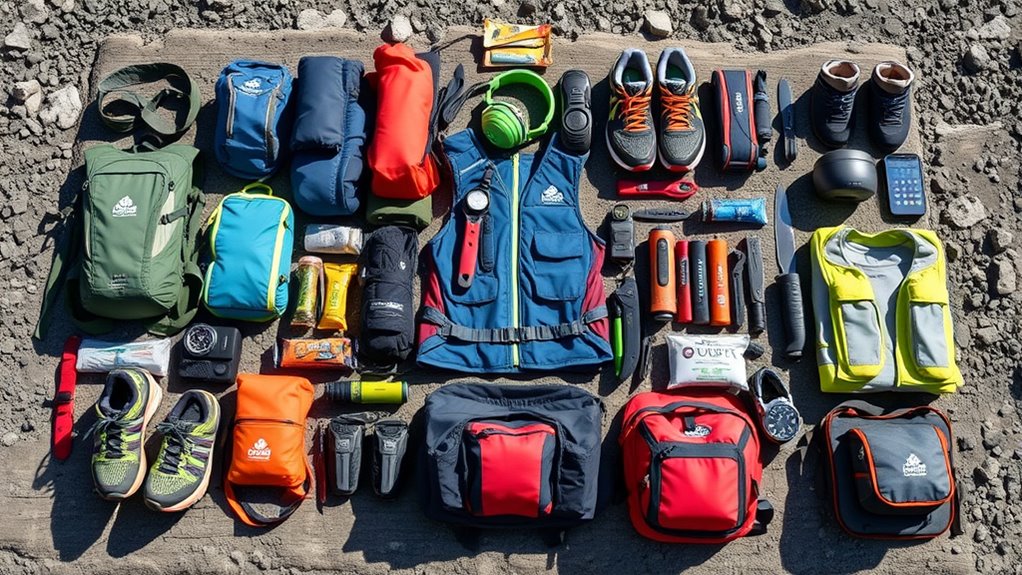
Trailblazing mountain and trail races demand specialized gear designed to handle rugged terrain, unpredictable weather, and technical obstacles. For trail running, your gear must be durable, lightweight, and reliable. Essential mountain gear includes sturdy trail shoes with aggressive traction, moisture-wicking clothing for changing conditions, a hydration pack for quick access to water, and a lightweight headlamp for early morning or late-night sections. Consider trail-specific accessories like trekking poles for stability and a compact emergency kit. Proper gear guarantees you stay safe and perform at your best on challenging courses. When selecting mountain gear, prioritize durability, comfort, and adaptability to unpredictable weather, so you can focus on conquering the trail rather than worrying about equipment failures.
Frequently Asked Questions
How Do I Choose the Right Footwear for Different Race Distances?
When choosing footwear for different race distances, you should prioritize shoe fit and comfort. For trail running, look for shoes with good traction and support to handle uneven terrain. Shorter races often require lighter shoes for speed, while longer distances need more cushioning and stability. Always try on shoes later in the day when your feet are swollen, ensuring a proper fit that prevents blisters and enhances performance.
What Clothing Materials Are Best for Various Weather Conditions?
When selecting clothing for different weather conditions, you want to focus on synthetic fabrics and moisture-wicking materials. These fabrics help keep you dry and comfortable by pulling sweat away from your skin, especially in hot or humid weather. For cold conditions, layer with moisture-wicking base layers and add insulating or waterproof outer layers. Always choose clothing that adapts to the weather to prevent chafing, overheating, or getting chilled during your run.
How Should I Prioritize Gear for a Multi-Day Stage Race?
You should prioritize gear that supports your race pacing and mental preparation for a multi-day stage race. Focus on lightweight, versatile clothing, reliable navigation tools, and sufficient nutrition supplies. Pack essentials like a hydration system and repair kit early, so you stay confident and adaptable. Remember, staying comfortable and organized helps you maintain steady progress, keeps your mind sharp, and guarantees you’re ready for the challenges each day brings.
What Hydration Strategies Are Recommended for Ultra-Marathons?
You should focus on maintaining proper hydration methods during ultra-marathons by drinking small amounts frequently rather than large gulps. Prioritize electrolyte balance by consuming drinks containing sodium, potassium, and other minerals to prevent cramping and hyponatremia. Listen to your body’s thirst cues, and consider using electrolyte tablets or gels. Consistent hydration helps sustain energy levels and reduces the risk of dehydration, ensuring you stay strong throughout your ultra-marathon.
How Can I Effectively Carry Nutrition During Long-Distance Races?
Think of your nutrition plan as a well-stocked treasure chest, ready to fuel your race. You can carry energy gels in your pockets or use hydration packs, which act like portable energy reservoirs. These options guarantee you’re never stranded in the desert of fatigue. Plan your intake at regular intervals, and choose what works best for you—simple gels or mixed nutrition—to keep your energy flowing like a steady river.
Conclusion
No matter the distance, your gear is the steady compass guiding your running journey. Think of each item as a brushstroke in your race masterpiece, blending comfort, speed, and endurance. With the right gear, you’re not just running—you’re confidently steering a vibrant trail of achievement. So pack smart, trust your gear, and let every step paint a bold, unstoppable story on the road ahead.
